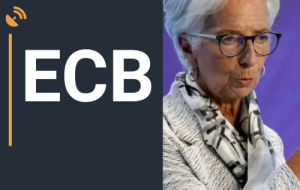Lagarde explains decision to leave interest rates unchanged in October
Share: Christine Lagarde, President of the European Central Bank (ECB), explains the ECB’s decision to leave the key interest rates unchanged in October and responds to questions from the press. ECB press conference key quotes “The economy is likely to remain weak for the rest of the year.” “The economy should strengthen over

Christine Lagarde, President of the European Central Bank (ECB), explains the ECB’s decision to leave the key interest rates unchanged in October and responds to questions from the press.
ECB press conference key quotes
“The economy is likely to remain weak for the rest of the year.”
“The economy should strengthen over the coming years as real incomes rise.”
“There are signs the labour market is weakening.”
“Inflation is likely to come down further in the near term.”
“Some inflation expectation indicators are elevated and need to be monitored closely.”
“Risks to economic growth are skewed to the downside.”
“We did not discuss remuneration of reserves.”
“Now is not the time for forward guidance.”
This section below was published at 12:15 GMT to the European Central Bank’s interest rate decision and the initial market reaction.
The European Central Bank (ECB) announced on Thursday that it left key rates unchanged following the October policy meeting. With this decision, the interest rate on the main refinancing operations and the interest rates on the marginal lending facility and the deposit facility will stay at 4.50%, 4.75% and 4.00%, respectively.
In its policy statement, the ECB noted that based on its current assessment, interest rates are at levels that, maintained for a sufficiently long duration, will make a substantial contribution to the inflation goal.
Follow our live coverage of the ECB policy announcements and the market reaction.
Market reaction to ECB interest rate decision
EUR/USD stays under modest bearish pressure and trades in negative territory following the ECB monetary policy announcements.
Euro price today
The table below shows the percentage change of Euro (EUR) against listed major currencies today. Euro was the weakest against the Australian Dollar.
| USD | EUR | GBP | CAD | AUD | JPY | NZD | CHF | |
| USD | 0.25% | 0.10% | 0.11% | -0.12% | 0.18% | -0.09% | 0.15% | |
| EUR | -0.25% | -0.16% | -0.15% | -0.39% | -0.08% | -0.35% | -0.09% | |
| GBP | -0.09% | 0.17% | 0.04% | -0.24% | 0.09% | -0.18% | 0.07% | |
| CAD | -0.11% | 0.14% | -0.02% | -0.25% | 0.07% | -0.20% | 0.05% | |
| AUD | 0.16% | 0.41% | 0.25% | 0.27% | 0.33% | 0.06% | 0.33% | |
| JPY | -0.20% | 0.08% | -0.09% | -0.07% | -0.34% | -0.30% | -0.03% | |
| NZD | 0.09% | 0.34% | 0.18% | 0.19% | -0.04% | 0.28% | 0.25% | |
| CHF | -0.18% | 0.09% | -0.08% | -0.06% | -0.30% | 0.01% | -0.26% |
The heat map shows percentage changes of major currencies against each other. The base currency is picked from the left column, while the quote currency is picked from the top row. For example, if you pick the Euro from the left column and move along the horizontal line to the Japanese Yen, the percentage change displayed in the box will represent EUR (base)/JPY (quote).
Key takeaways from ECB policy statement
“Future decisions will ensure that policy rates will be set at sufficiently restrictive levels for as long as necessary.”
“In particular, interest rate decisions will be based on the assessment of inflation outlook in light of incoming economic and financial data, dynamics of underlying inflation and strength of monetary policy transmission.”
“APP and Pandemic Emergency Purchase Programme (PEPP) portfolio is declining at a measured and predictable pace, as Eurosystem no longer reinvests principal payments from maturing securities.”
“ECB intends to reinvest principal payments from maturing securities purchased under PEPP until at least the end of 2024.”
“In any case, future roll-off of PEPP portfolio will be managed to avoid interference with appropriate monetary policy stance.”
“ECB will continue applying flexibility in reinvesting redemptions coming due in PEPP portfolio, with a view to countering risks to monetary policy transmission mechanism related to pandemic.”
This section below was published as a preview of the European Central Bank’s interest rate decision at 07:00 GMT.
- The European Central Bank is set to keep key interest rates steady on Thursday after ten consecutive hikes.
- ECB’s Lagarde could strike a hawkish tone amid upside risks to inflation on Middle East strife.
- The Euro volatility will likely spike up on the ECB decision and Lagarde’s presser.
Ten meetings later and after an unprecedented 450 basis points increase in interest rates in less than two years, the European Central Bank (ECB) is set to keep borrowing costs steady on Thursday. The decision will be announced at 12:15 GMT, followed by ECB President Christine Lagarde’s press conference at 12:45 GMT. There will be no publication of the updated staff projections at this meeting.
European Central Bank interest rate decision: What to know in markets on Thursday
- EUR/USD is sitting at the lowest level so far this week near 1.0550, courtesy of risk aversion fueled by Mideast tensions and surging US Treasury bond yields.
- The benchmark 10-year US Treasury bond yield is closing in on the 5.0% level yet again,
- In a televised statement late Wednesday, Israeli Prime Minister Benjamin Netanyahu said that Israel is preparing a ground invasion of Gaza.
- US S&P 500 futures trade with sizeable losses, as a result of global flight to safety.
- Germany’s IFO Business Climate Index for October came in higher than expected at 86.9 on Wednesday, beating the market forecast of 85.9. This was the first monthly increase after five consecutive declines.
- On Tuesday, HCOB’s flash Eurozone Composite Purchasing Managers’ Index (PMI), compiled by S&P Global, fell to 46.5 in October from September’s 47.2, its lowest since November 2020.
- The ECB event is expected to provide a fresh directional impetus to the EUR/USD pair, with attention turning toward next week’s Fed policy announcements.
What is expected from the next ECB meeting and how will it impact EUR/USD?
Economists are widely expecting the European Central Bank (ECB) to announce a pause on Thursday, keeping the Deposit Rate steady at 4% while maintaining the Refinancing operations lending rate at 4.5%.
Despite a steady interest rate decision, markets are betting on a hawkish message from ECB President Christine Lagarde at the press conference, keeping hopes alive for an interest rate hike in December. Renewed geopolitical threat, emanating from the Hamas-Israel military conflict, poses upside risks to the Eurozone’s inflation outlook, which could make it difficult for the central bank to reach its 2.0% target by end-2025, as previously projected. As a net energy importer, the region is directly impacted by rising Oil and Gas prices amidst escalating Middle East tensions.
However, the debate for the next interest rate hike is for the December policy meeting. For this week’s gathering, ECB policymakers could discuss the non-interest rate monetary policy tools, including minimum reserves, reversed tiering and a possible earlier unwinding of the reinvestment of bond purchases under the Pandemic Emergency Purchase Programme (PEPP).
Last month, Reuters reported, citing six sources, that ECB officials “want to soon start discussing how to tackle the multi-trillion-Euro pool of excess liquidity sloshing around banks, with raising reserve requirements a possible first move.”
But the central bank could refrain from tightening financial conditions further, as they assess the lag effect of their interest rate hikes on the economy and inflation prospects. The central bank for over 20 countries that use the Euro has already raised interest rates 10 times to record levels, increasing stagflation risks.
Eurozone’s annual inflation fell to 4.3% in September, cooling to its lowest level since October 2021. The contraction in the Eurozone business activity deepened in October, a survey showed, suggesting the old continent could slip into recession. These data supported the case for an ECB pause on Thursday.
Analysts at BBH noted: “European Central Bank meets Thursday and is expected to keep rates steady. While there are still a handful of hawkish holdouts, most ECB policymakers have acknowledged that the tightening cycle is over.”
“The bank is expected to discuss modifications to reserve requirements as well as how to shrink its PEPP holdings but no decisions are expected until next year. Updated macro forecasts won’t come until the December 14 meeting. Of note, WIRP suggests no odds of a hike this week, rising to top out at only 10% for December 14. A rate cut is nearly priced in for June 6,” BBH analysts added.
If the ECB holds rates and President Lagarde delivers a hawkish message, leaving the door ajar for a December rate hike, EUR/USD could extend its recovery toward 1.0800. On the contrary, an ECB pause combined with a dismissal of potential upside risks to inflation expectations could be viewed as a dovish pause. In this case, the EUR/USD pair could resume its downtrend toward 1.0500.
Dhwani Mehta, Asian Session Lead Analyst at FXStreet, offers a brief technical outlook for the major and explains: “EUR/USD has breached the short-term critical 21-day Simple Moving Average (SMA) on its three-day downtrend that extends into Thursday. The 14-day Relative Strength Index (RSI), however, is pointing lower below the 50 level, indicating that downside risks remain intact for the pair.”
Outlining important technical levels to trade the EUR/USD pair, Dhwani notes: “The immediate support is aligned at the previous week’s low of 1.0511. A sustained break below the latter will put the focus back on the multi-month trough of 1.0448. The last line of defense for Euro buyers is seen at the 1.0400 round level. Conversely, buyers need acceptance above 1.0600 to revive the uptrend toward the 50-day SMA at 1.0665. The next topside target is pegged at the 1.0700 threshold.”
Euro FAQs
The Euro is the currency for the 20 European Union countries that belong to the Eurozone. It is the second most heavily traded currency in the world behind the US Dollar. In 2022, it accounted for 31% of all foreign exchange transactions, with an average daily turnover of over $2.2 trillion a day.
EUR/USD is the most heavily traded currency pair in the world, accounting for an estimated 30% off all transactions, followed by EUR/JPY (4%), EUR/GBP (3%) and EUR/AUD (2%).
The European Central Bank (ECB) in Frankfurt, Germany, is the reserve bank for the Eurozone. The ECB sets interest rates and manages monetary policy.
The ECB’s primary mandate is to maintain price stability, which means either controlling inflation or stimulating growth. Its primary tool is the raising or lowering of interest rates. Relatively high interest rates – or the expectation of higher rates – will usually benefit the Euro and vice versa.
The ECB Governing Council makes monetary policy decisions at meetings held eight times a year. Decisions are made by heads of the Eurozone national banks and six permanent members, including the President of the ECB, Christine Lagarde.
Eurozone inflation data, measured by the Harmonized Index of Consumer Prices (HICP), is an important econometric for the Euro. If inflation rises more than expected, especially if above the ECB’s 2% target, it obliges the ECB to raise interest rates to bring it back under control.
Relatively high interest rates compared to its counterparts will usually benefit the Euro, as it makes the region more attractive as a place for global investors to park their money.
Data releases gauge the health of the economy and can impact on the Euro. Indicators such as GDP, Manufacturing and Services PMIs, employment, and consumer sentiment surveys can all influence the direction of the single currency.
A strong economy is good for the Euro. Not only does it attract more foreign investment but it may encourage the ECB to put up interest rates, which will directly strengthen the Euro. Otherwise, if economic data is weak, the Euro is likely to fall.
Economic data for the four largest economies in the euro area (Germany, France, Italy and Spain) are especially significant, as they account for 75% of the Eurozone’s economy.
Another significant data release for the Euro is the Trade Balance. This indicator measures the difference between what a country earns from its exports and what it spends on imports over a given period.
If a country produces highly sought after exports then its currency will gain in value purely from the extra demand created from foreign buyers seeking to purchase these goods. Therefore, a positive net Trade Balance strengthens a currency and vice versa for a negative balance.
| آموزش مجازی مدیریت عالی حرفه ای کسب و کار Post DBA + مدرک معتبر قابل ترجمه رسمی با مهر دادگستری و وزارت امور خارجه |  آموزش مجازی مدیریت عالی و حرفه ای کسب و کار DBA آموزش مجازی مدیریت عالی و حرفه ای کسب و کار DBA+ مدرک معتبر قابل ترجمه رسمی با مهر دادگستری و وزارت امور خارجه |  آموزش مجازی مدیریت کسب و کار MBA آموزش مجازی مدیریت کسب و کار MBA+ مدرک معتبر قابل ترجمه رسمی با مهر دادگستری و وزارت امور خارجه |
 مدیریت حرفه ای کافی شاپ |  حقوقدان خبره |  سرآشپز حرفه ای |
 آموزش مجازی تعمیرات موبایل آموزش مجازی تعمیرات موبایل |  آموزش مجازی ICDL مهارت های رایانه کار درجه یک و دو |  آموزش مجازی کارشناس معاملات املاک_ مشاور املاک آموزش مجازی کارشناس معاملات املاک_ مشاور املاک |
برچسب ها :CentralBanks ، decision ، Ecb ، EURUSD ، Explains ، interest ، InterestRate ، Lagarde ، leave ، October ، Rates ، seo ، Unchanged
- نظرات ارسال شده توسط شما، پس از تایید توسط مدیران سایت منتشر خواهد شد.
- نظراتی که حاوی تهمت یا افترا باشد منتشر نخواهد شد.
- نظراتی که به غیر از زبان فارسی یا غیر مرتبط با خبر باشد منتشر نخواهد شد.





ارسال نظر شما
مجموع نظرات : 0 در انتظار بررسی : 0 انتشار یافته : ۰